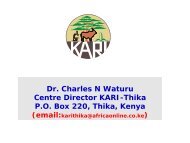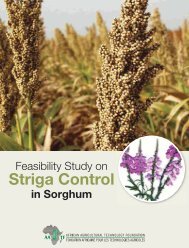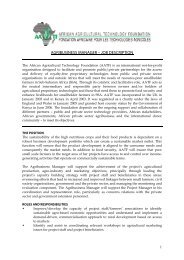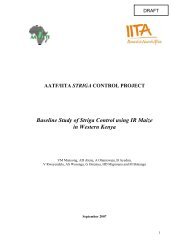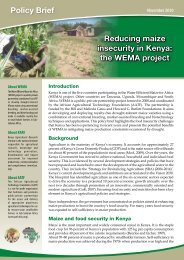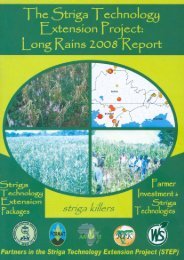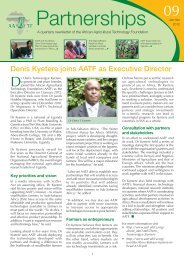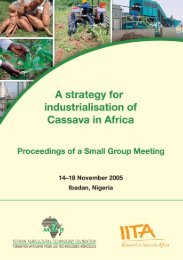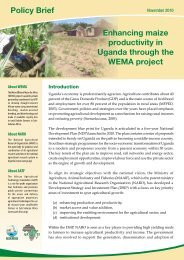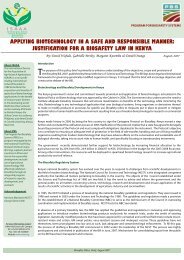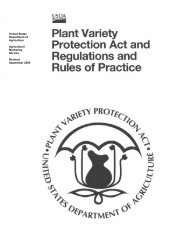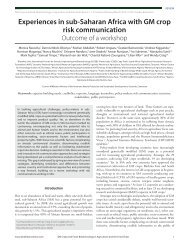AATF Inaugural Report - African Agricultural Technology Foundation
AATF Inaugural Report - African Agricultural Technology Foundation
AATF Inaugural Report - African Agricultural Technology Foundation
You also want an ePaper? Increase the reach of your titles
YUMPU automatically turns print PDFs into web optimized ePapers that Google loves.
A New Bridge to Sustainable <strong>Agricultural</strong> Development in Africa<br />
Africa (FARA), and the Economic Commission<br />
for Africa (ECA). It is also working in concert with<br />
an array of regional and sub-regional organisations,<br />
including the Economic Community of West<br />
<strong>African</strong> States (ECOWAS), the Common Market<br />
for Eastern and Southern Africa (COMESA),<br />
the Southern <strong>African</strong> Development Community’s<br />
Food, Agriculture and Natural Resources group<br />
(SADC/FANR), the Association for Strengthening<br />
<strong>Agricultural</strong> Research in Eastern and Central<br />
Africa (ASARECA), and the West and Central<br />
<strong>African</strong> Council for <strong>Agricultural</strong> Development<br />
(CORAF/WECARD).<br />
Selecting Projects<br />
As <strong>AATF</strong> evolves in response to changing needs<br />
and new opportunities, its project portfolio also<br />
evolves. The initial projects that have been undertaken<br />
by the <strong>Foundation</strong> reflect – and are meant<br />
to demonstrate – a range of technologies that can<br />
be effectively adapted to <strong>African</strong> conditions and<br />
that are valued by resource-poor farmers. Selection<br />
criteria include consideration of the overall<br />
balance of the portfolio, as well as project-specific<br />
factors.<br />
In general terms, the <strong>Foundation</strong>’s portfolio<br />
should include projects of differing sizes, expenditure<br />
profiles and risks, providing balance in terms<br />
of risk and expected outcomes. Other important<br />
balance considerations include geographic distribution,<br />
the potential for impact in the short run,<br />
and inherent technical or institutional synergies<br />
between projects.<br />
More specifically, selected projects must<br />
address high-priority constraints limiting access<br />
to and use of technologies that would otherwise<br />
be available (particularly those held or used by<br />
the private sector). Selected projects must also<br />
involve potential end-users in problem definition,<br />
selection of technology interventions, and project<br />
planning, implementation, monitoring and evaluation.<br />
Projects will be pursued only if it is clear<br />
that, in the target country(s) or region, constraints<br />
to sustainable and profitable use by smallholders<br />
are either being overcome or can be addressed in a<br />
reasonable timeframe and at reasonable cost.<br />
The selection of projects reflects the essence<br />
of the <strong>Foundation</strong>’s business model, as shown in<br />
Figure 4 opposite.<br />
This 14-step project development process<br />
comprises four distinct but interrelated phases.<br />
The process begins by assessing the constraints to<br />
reducing poverty and improving the food security<br />
of sub-Saharan Africa’s resource-poor farmers,<br />
and by identifying options for overcoming those<br />
constraints (Phase 0). All projects are guided<br />
by carefully prepared business plans (Phase 1),<br />
which lead to the development and deployment<br />
of products (Phases 2 and 3) by project partners.<br />
In each phase, strategic decisions are made that<br />
inform and condition subsequent steps and decision<br />
making.<br />
To date, <strong>AATF</strong> has focused its efforts on<br />
building alliances that expedite access to, and<br />
delivery of, appropriate new technologies. It is<br />
involved in two flagship projects that, to varying<br />
degrees, feature these twin objectives.<br />
Controlling Striga<br />
This project aims at reducing the impact of the<br />
parasitic weed Striga on maize production. The<br />
<strong>Foundation</strong>’s involvement in this project began after<br />
consultations with the International Maize and<br />
Wheat Improvement Center (CIMMYT). <strong>AATF</strong>’s<br />
role is to facilitate the deployment of the technology,<br />
both in Kenya and in other Striga-infested<br />
areas in sub-Saharan Africa, and to make sure that<br />
it reaches smallholder maize producers.<br />
28



